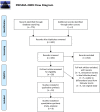Ovarian stimulation in the luteal phase: systematic review and meta-analysis
- PMID: 27146151
- PMCID: PMC4974222
- DOI: 10.1007/s10815-016-0721-5
Ovarian stimulation in the luteal phase: systematic review and meta-analysis
Abstract
Purpose: The purpose of this study was to evaluate whether outcomes are different if controlled ovarian stimulation (COS) is started in the luteal phase rather than the follicular phase.
Methods: A systematic review and meta-analysis was performed. Sixteen studies were included in the qualitative analysis, and eight studies with a total of 338 women were included in the quantitative analysis.
Results: Cycles initiated in the luteal phase were slightly longer (WMD 1.1 days, 95 % CI 0.39-1.9) and utilized more total gonadotropins (WMD 817 IU, 95 % CI 489-1144). However, no differences were noted in peak estradiol levels (WMD -411 pg/ml, 95 % CI -906-84.7) or in the total number of oocytes retrieved (WMD 0.52 oocytes, 95 % CI -0.74-1.7). There were slightly more mature oocytes retrieved in the luteal phase (WMD 0.77 oocytes, 95 % CI 0.21-1.3), and fertilization rates were significantly higher (WMD 10 %, 95 % CI 0.03-0.18). While only three studies reported pregnancy outcomes, no difference was noted in the FET pregnancy rates after COS in the luteal versus follicular phase (RR 0.95, 95 % CI 0.56-1.7). A post hoc power analysis revealed that a sample of this size was sufficient to detect a clinically meaningful difference of 2 oocytes retrieved with 93 % power.
Conclusion: Although initiating COS in the luteal phase requires a longer stimulation and a higher dose of total gonadotropin, these differences are not clinically significant. Furthermore, COS initiated in the luteal phase does not compromise the quantity or quality of oocytes retrieved compared to outcomes of traditional stimulation in the follicular phase.
Keywords: Controlled ovarian stimulation; Fertility preservation; In vitro fertilization; Luteal phase; Oocyte cryopreservation.
Figures


References
-
- Howlader N, Noone A, Krapcho M, Garshell J, Miller D, Altekruse S, et al. SEER Cancer Statistics Review, 1975–2012, National Cancer Institute. Bethesda, MD, http://seer.cancer.gov/csr/1975_2012/, based on November 2014 SEER data submission posted to the SEER website. 2015.
-
- Fertility preservation in patients undergoing gonadotoxic therapy or gonadectomy: a committee opinion. Fertil Steril 2013;100(5):1214–23. - PubMed
Publication types
MeSH terms
Grants and funding
LinkOut - more resources
Full Text Sources
Other Literature Sources

